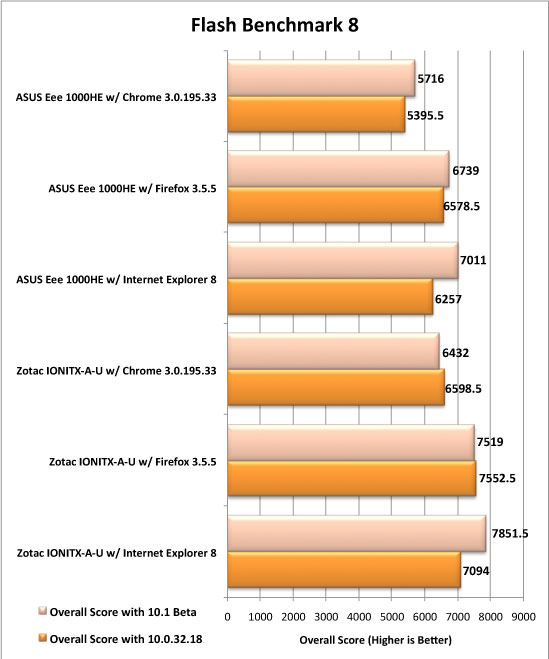Adobe Flash 10.1 Ushers In GPU Accelerated Flash!
The Benchmark Results

The Flash Benchmark 8 test software is a Flash application that puts
the system through varying levels of graphics tests, starting with
lower requirements and moving higher until the system can no longer
attain an average of 25 FPS. Being a Flash application, it’s results
are based on the version of Flash, the browser, and the operating
system. As such, the above chart displays results for Flash 10 and 10.1
between all three test browsers and between the two test systems. Each
test was run twice, with the average taken as the final reading.
While there is a lot of information packed into this chart, try to
avoid number-numbness and keep in mind that the lighter-orange color is
Flash 10.1. In summary, there are a lot of conclusions we can make. For
instance, the Zotac board had more power than the ASUS netbook, which
makes sense considering the Zotac board sports NVIDIA’s GeForce 9400m
discrete graphics chipset. We can also see that Chrome has the worst
ratings across the board, while Firefox performs best with Flash 10.0
and Internet Explorer performs best with Flash 10.1.
Surprisingly, tests between 10.0 and 10.1 were very similar for
each browser, with the exclusion of Internet Explorer that
unexplainably found a very significant performance boost. This might
indicate that the Flash 10.1 pre-release is currently more complete for
Internet Explorer than for Firefox or Chrome, or that the plug-in
structures of Firefox and Chrome limit individual plug-in performance
in some way. Chrome, for instance, has a sandboxed strategy to plugins
that quite clearly imposes some performance constraints on the Flash
plugin. Nonetheless, it appears that Flash 10.1 currently does not
boast many performance gains unless users happen to still use Internet
Explorer. Confusing, right?

Now on to the topic of the hour, which is our benchmark looking
specifically at video processing. To perform this test, I located a YouTube video offered in SD, 720P, and 1080P resolutions. I then loaded perfmon.exe
on the Zotac IONITX-A-U to measure a running average of CPU usage over
a 1 minute period of streaming. In each test, the first minute of the
video was played back without any other activity on the system. As
such, the results bundle together browser and Flash playback CPU
utilization, representing an accurate real-world usage test.
It’s easy to see in the chart above what an incredible difference
Flash 10.1 makes! With Flash 10.0, SD played smoothly, while 720P lost
a barely noticeable number of frames and 1080P played terribly, bogging
down the entire computer so much that Internet Explorer locked up and
the process had to be killed in Task Manager. Firefox had a similar
locking result, though it did eventually respond on its own. A credit
to Google’s Chrome sandboxing approach, closing out the browser was
immediate even if the video playback was the worst.
Switch forward to Flash 10.1, and the difference is light and day!
CPU utilization across all three browsers was cut down to cool, easily
manageable figures, while playback of all three modes was smooth and
the browsers remained responsive. I was so surprised with the outcome
of the 720P and 1080P tests that I reran the experiment multiple times.
Of course, it begins to make sense when considering the fact that Flash
10.1 uses hardware acceleration to decompress the streaming video,
meaning the CPU is largely babysitting in-memory data transfers while
the GPU performs the fancy high-def work.
After experiencing both sides of the coin, the only thing I can say
is that Adobe has prepared an excellent upgrade to its Flash product
line. Well, after two years of H.264 support, it’s about time.

Comments are closed.